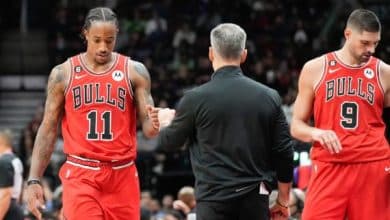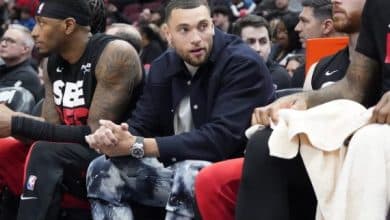
The meeting was held at the Marriott “Hotel Ambassador”, boulevard Haussmann. It is 9 am, this Friday, the first fans begin to crowd in front of the entrance hoping to catch a glimpse of the NBA superstars and Mike Mancias welcomes us to the luxury residence privatized by the American federation. Grant Hill is returning from a short walk while we settle in with LeBron James' physical trainer.
The day before, the United States beat Serbia in an epic match and the “King” achieved a triple-double that is very rare at the Olympic Games, defending Nikola Jokic during “money-time”. Is the man who has been training him for twenty years still surprised by what the winger is achieving, even though he is almost 40 years old?
“Yesterday we were just talking about that.” he answers us with a smile. “It was early in the morning and he was lifting weights to get ready for the game that night (against Serbia). And someone asked me that question. And I told him I wasn’t surprised because I knew how hard he worked. Yesterday was a perfect example. He had a great game, a triple-double, but he was in the gym at eight in the morning, doing weights, with no one around to watch him. So no, I’m not surprised. I would be surprised if he had that kind of game eating all over the place and not training hard (laughs).”
“My relationship with LeBron was built on work. I didn't seek to be his personal trainer, I never asked him to. I wanted to be in the NBA.”
The relationship between the two men began in 2004, when Mike Mancias took several years to fully integrate into the NBA.
“I didn’t know that’s what I wanted to do until my senior year of high school, when I wanted to mix basketball, sports and medicine. A friend told me that I should look into sports medicine. There was this university (University of Texas–Pan American) that offered it, an hour from my house. I did my first years of study there. I helped out with the basketball team, volleyball team, soccer team… In the middle of all that, I thought I could do the same thing on the professional level. So I started doing internships with professional teams, but also hospitals and clinics, to get experience, information. And in 1998, the strength and conditioning coach for the Houston Rockets helped me get into the NBA pre-Draft camp and that’s when I started working with the pros. Then the Milwaukee Bucks took me on as a summer intern. The Cavaliers also offered me an internship, then a year-round internship. It was LeBron James' second year in the NBA, and that's where we met.”
A bond of trust is then born between the two.
“My relationship with LeBron was built on work. I didn’t try to be his personal trainer, I never asked him to. I wanted to be in the NBA. But he saw what I was doing, he asked me to work on things with him. Then he asked me to go to his house the night before games, to work. This routine, the evening before game days, with stretching, treatments, massages, is the routine that we put in place almost all year, in 2006/07, and they went to the NBA Finals. So he saw that he was playing well, that he felt good thanks to this preparation work. And he understood that the more he prepared, the better he performed on the courts.”
But LeBron James didn't come to the NBA with this routine. It was built over time, although Mike Mancias tells us that it became essential to him much sooner than it did to most players.
“Before that, he didn’t really have a routine. He stretched on his own but he didn’t use ice, he did weight training maybe once every two or three weeks. He was 19, he had fresh legs, a lot of energy, he was already very strong, he was already a good player but after the games, he would leave. He didn’t do any treatment and so it was very interesting to see the evolution of his program.”
“At the time, there was only one trainer per team. Now, there are five or six…”
Today, the “King's” physical trainer is releasing a book, “Game Plan – My method for excelling over time”obviously prefaced by LeBron James, to share his precepts and what he learned and developed during his twenty years alongside the Team USA winger and the other athletes he was able to rub shoulders with.

“In Cleveland, I was an intern at first and I didn’t do all the trips, just the ones that were multiple days. I did that for a year and then Dan Gilbert bought the team (in 2005) and he asked the players what they needed. They told him they wanted two full-time strength and conditioning coaches because one wasn’t enough. So I applied for the job and I got it. So back then, there was only one coach per team. Now, there are five or six…”
And if LeBron James said that Mike Mancias was the key to his longevity, and that he would never have been able to play so long without him, the person concerned tempers this, especially highlighting the basketball player's flair.
“He always surrounded himself with the right people at the right time. He already had people around him, veterans who knew the NBA, with Nike, who were advising him, who were telling him to take care of his body. And then let’s be honest: Nike had invested $100 million in this 19-year-old kid so they wanted to see their return on investment. And our paths crossed at the perfect time.”
As Steve Kerr explained with Stephen Curry, the element that best explains LeBron James' longevity, according to Mike Mancias, is his attachment to his physical routine.
“He challenges himself to do this routine every day of the year. Because there is a domino effect on his performance during matches. So you have to find challenges every day to do this routine, despite the fatigue. Because you develop this mentality of taking on challenges, even if they are small daily challenges.”
For his part, the physical trainer constantly observes his protégé during matches.
“I've been to most of his games, front row, and I see how he moves, the hits he takes. So when we go into the weight room, I can replicate that so he's more comfortable with those specific movements and the impacts he faces when he's on the field.”
In recent years, he has adapted LeBron James' training to work more on reflexes, in the same way as tennis players.
“The older we get, in sports or in life in general, the more we lose our reflexes. We can still go fast but changes of pace are more complicated, and that’s something we’ve been working on a lot in recent years. On continuing to go fast, but especially on changing direction faster. While remaining under control. Because the older we get, the more we lose this reaction time. So we do a lot of work on hand/eye coordination, on the brain, neuromuscular work with lights, objects to catch. But also on stopping and starting quickly.” Apparently, it works pretty well…












